Phosphate / Dietary Phosphorus Binders for Dogs and Cats
Management of CKD / CRF in Dogs and Cats
Chronic kidney disease (CKD) is a common, irreversible, and progressive disease in dogs and cats. In patients with CKD, mineral and bone disorders occur due to impaired kidney function. Hyperphosphatemia is known to be a prognostic factor for shorter survival time in dogs with CKD. It also can speed up the progression of the CKD and can be fatal if left untreated. Therefore, prevention and management of hyperphosphatemia may improve the prognosis of dogs and cats with CKD.
Dogs and cats suffering from chronic renal disease (CKD) shows increased serum phosphorus levels. CKD is managed by a multimodal approach based on urine and blood work results. Renal secondary hyperphosphatemia is one of the challenges in CKD patients.
Primary efforts include switching to a prescription diet or renal diet which is low in protein and salt. This is the first line of defense and enteric phosphate binders are considered as second line of defense (stage 2 of CKD). When serum phosphorus level is > 4.6 mg/dL then you should consider oral supplementation with phosphorus binders. Renal supplements, probiotics-prebiotics also helps in reducing toxins and improving renal health in pets suffering from CKD.
Low salt, low phosphorus and low protein diets are recommended for pet suffering from renal disorders. High protein diets like cheese, red meat, jerky treats, raw hides commercial dog or cat treats should be avoided. High salt diets may contribute to renal secondary hypertension and may worsen the kidney damage.
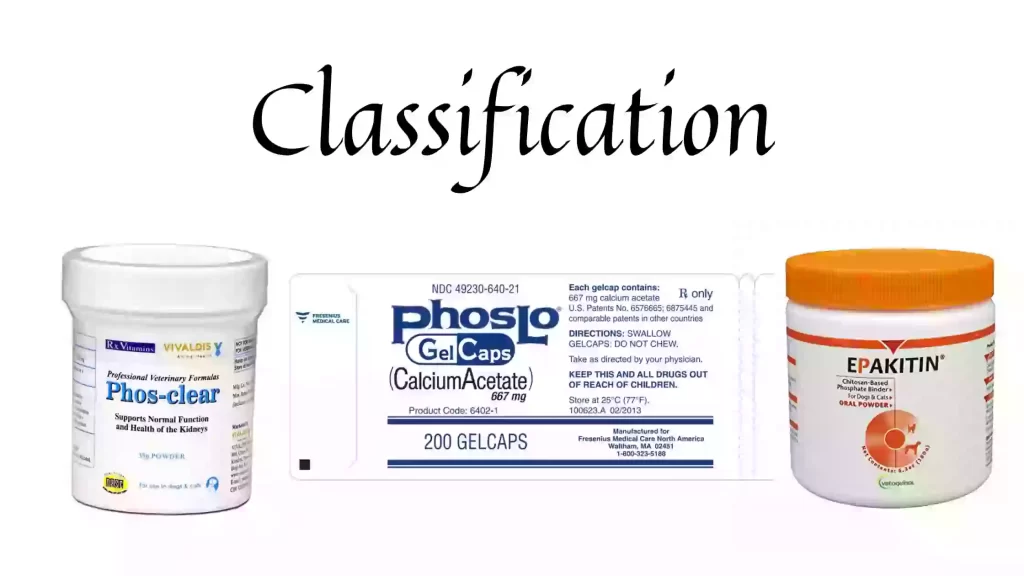
Classification of Phosphate Binders
On the basis of active ingredient of principle phosphate binding salt phosphate binders can be divided into following categories:
- Aluminium based phosphate binders:
- Calcium based phosphate binders:
- Aluminium – calcium free phosphate binder
A. Aluminium based phosphate binders:
Aluminium based phosphate binders also acts as an antacid as well. These are poorly absorbed from gut but have shown toxic side effects in long term. Simultaneous administration with acidic food or diet may significantly increase the absorption and risk of Aluminium toxicity. These can be prescribed for short term use or in case of ineffectiveness of other phosphate binders or poorly controlled phosphorus.
Dosage:
10-30 mg/kg orally every 6-8 hours or 0.1- 0.5 ml (2-30 ml) of gel/ suspension
e.g. Aluminium hydroxide (Brand names: Alternagel, Amphojel), Aluminium carbonate
Side Effects:
Evaluation of red blood cell (RBC) in all animals receiving aluminium-containing phosphate binders is suggested. Commonly observed side effects due to long term use of Aluminium based phosphate binders are –
- Risk of aluminium toxicity; reported in dogs with renal disease after 2 to 6 weeks on doses of 126 to 200 mg/kg/day of aluminium hydroxide
- Signs of toxicity includes lethargy, neurologic signs, progressive microcytosis, microcytic anaemia
- Reduced serum albumin concentrations
- Can also lead to softening of bones
B. Calcium based phosphate binders:
These are known to replace Aluminium-based binders. Calcium salts are an alternative to Aluminium salts where toxicity or side effects are problem. Calcium levels / hypercalcemia should be monitored in case of long-term therapy. According to some authors using calcium-based phosphate binders and calcitriol together is controversial and contraindicated; while others state that intensified monitoring for hypercalcemia is required.
Larger doses are needed to be effective but are relatively inexpensive.
Dosage:
60-90 mg/kg every 24 hours in divided doses
(Dosage are different in hypocalcemia and hyperkalemic cardiotoxocity)
e.g. Calcium carbonate, Calcium acetate, Calcium citrate
Calcium carbonate – calcium carbonate is the most commonly used compound in calcium-based phosphate binders. Calcium carbonate is also known as Tums. Use of tums sticks in pets for the control of increased serum phosphorus levels is not popular. It is also available in eggshells but alone it is not effective.
Calcium acetate (e.g. Phoslo, ChemPhos)
Calcium acetate is a better phosphate binder than calcium carbonate and hypercalcemia is also lesser.
Calcium citrate – Non-Aluminium containing phosphate binding agent.
Side effects are –
- Risk of hypercalcemia (more when administered with Calcitriol)
- Increased risk for soft tissue and vascular calcification, and may also be a risk factor for calciphylaxis.
- Deposition in blood stream and small blood vessels may cause organ damage.
- Restriction of total intake of calcium prevents the use of calcium-containing binders at doses sufficient to adequately control serum phosphate.
C. Aluminium - calcium free phosphate binder
These are considered to be safer in long term se in CKD patients.
e.g. Lanthanum carbonate, Sevelamer carbonate, Magnesium Based, Chitosan Based Binders, Iron Based Phosphate Binders
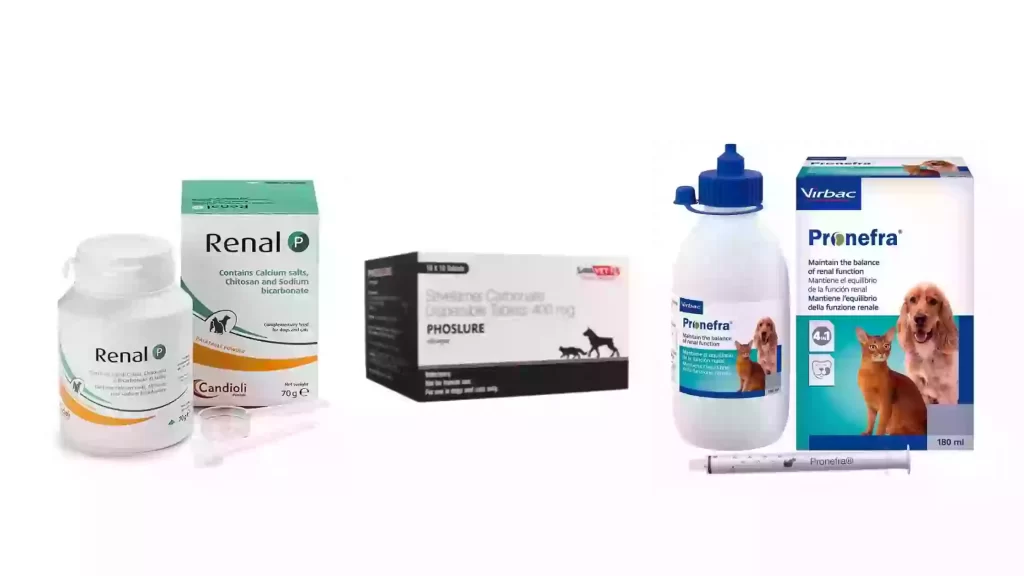
1. Magnesium based phosphorus binders:
Works as an alternative to calcium-based phosphate binders where hypercalcemia is there. But serum concentration levels should be monitored. Magnesium based phosphate binders are appropriate for peritoneal dialysis patients in humans and should be avoided if patient is not on dialysis.
2. Lanthanum carbonate
Forms insoluble complexes with phosphate in the gut. It is not recommended in case of acute renal failure. Water should be available all the times when using lanthanum carbonate.
It is more potent than Sevelamer and binds more phosphate than any other phosphorus binder.
Dosage:
Dogs: 100 mg/kg/day orally in divided dosage
Cats: 400-800 mg/cat/day in divided dosage
Side Effects
- Accumulation of lanthanum in bone, liver, and gastric mucosa has been reported
- Concerns of lanthanum toxicity
3. Sevelamer carbonate / Sevelamer hydrochloride
Sevelamer is a calcium and aluminium free hydrogel of cross-linked poly-allylamine. It treats hyperphosphatemia in patients with chronic kidney disease without the risk of hypercalcemia or aluminium toxicity. It also reduces cholesterol levels (LDL cholesterol).
Significantly slows the progression of vascular calcification as compared to calcium phosphate binders. It reduces cardiovascular morbidity and mortality.
Sevelamer carbonate is improved form of sevelamer hydrochloride with
Cats & Dogs: 30-40 mg/kg orally every 8 hours with meals
e.g. Phoslure Tablets
Advantages:
- Helps to treat hyperphosphatemia in patients with chronic kidney disease without the risk of hypercalcemia or aluminium toxicity
- Significantly slows the progression of vascular calcification as compared to calcium-phosphate binders
- Reduces cardiovascular morbidity and mortality
Side effects:
- Hygroscopic in nature. Can cause constipation.
- Concerns are there on use of sevelamer hydrochloride in CKD stage 3 and stage 4 patients due to lower bicarbonate levels leading to gradual weakening of bones (renal osteodystrophy). Bicarbonate levels can be monitored along with phosphorus in such patients. But these side effects are lesser with sevelamer carbonate and also has fewer GI side effects.
4. Chitosan based phosphate binders
Chitosan is a natural polysaccharide derived from chitin (outer skeleton of shellfish, crab, lobster and shrimp etc.). It is a uremic toxin binder and also shown to reduce creatinine and urea levels.
Usually comes in combination with other phosphate binders like calcium carbonate.
e.g. Pronefra, Epikatin / Epakitine, Renal P,
Side Effects
- Persistent low levels of serum phosphorus even after discontinuation of therapy attributed to a residual effect of chitosan bound to the intestinal tract because of its muco-adhesive properties
- Reduction in PTH levels
5. Iron based phosphate binders:
Ferric citrate and sucroferric oxyhydroxide are newly approved iron-containing phosphate binders in human medicine. Ferric citrate allows significant oral iron uptake in comparison to sucroferric oxyhydroxide and therapy necessitates monitoring of iron levels. Usage and dosage in dogs and cats have not been established.
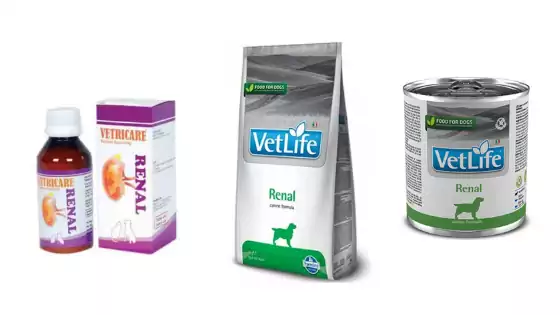
Prescription diets / Renal Diets:
These diets are low in protein and salt amount. They also supplement with omega- 3 fatty acids and alkalinized (potassium) to help offset the metabolic acidosis associated with CKD. Phosphate binders can be combined with or can be given along with renal prescription diets.
e.g. Royal Canin Renal, Hills K/D, Farmina (vetlife) Renal
FAQs:
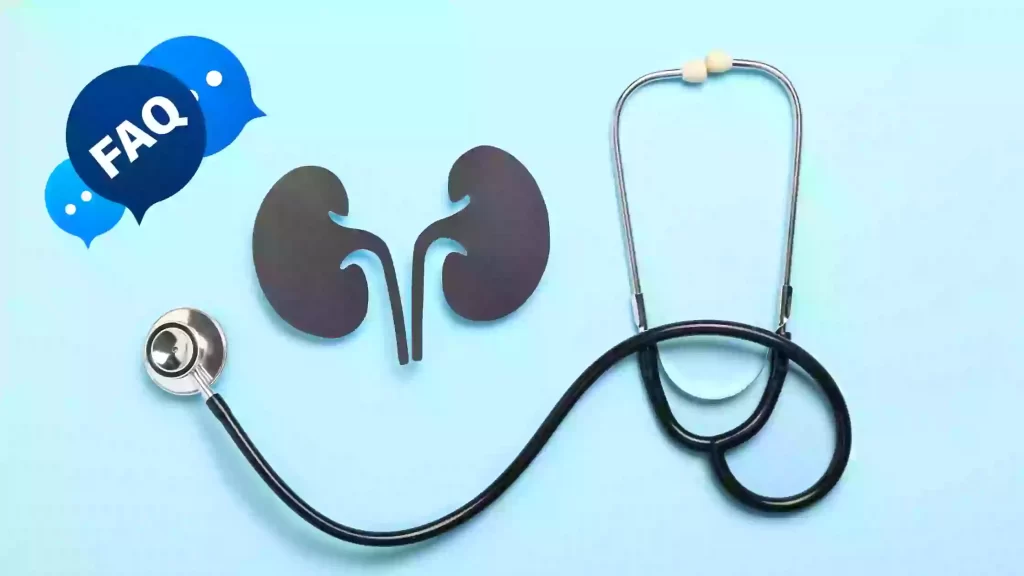
What is a phosphate binder?
Phosphate binders are oral supplements / medicines which are used to lower serum phosphorus levels in case of hyperphosphatemia or increased phosphorus levels resulted from kidney dysfunction or chronic kidney disease.
How does phosphorus binders work?
It binds with excess dietary phosphorus, forms a neutral compound and helps to pass excess phosphorus out of the body in the feces. Only a limited amount or reduced phosphorus is absorbed in the bloodstream through intestine.
How long does it take in effect of onset?
Phosphate binders are administered a few minutes (5 to 10 minutes) before or immediately after meal. It can also be mixed with the food. In short it should be there in the gut at the time of absorption to bind with excess phosphorus and reduce its availability for absorption.
Clinical signs of hyperphosphatemia?
Increased thirst, polyurea, diluted urine (low specific gravity), dehydration or other signs associated with CKD are commonly seen. But blood tests are the only way for confirmation.
When to switch giving oral phosphate binder to pets suffering with CKD?
Regular monitoring of phosphorus levels is necessary and even after one month of dietary changes it remains high then consider switching to phosphate binders or serum phosphorus levels are above 4.6 mg/dL.
Phosphorus binders come in picture at stage 2 and beyond in CKD according to IRIS (International Renal Interest Society). Supplementation of phosphate binder in each stage of renal failure is aimed to keep serum phosphate levels around target serum phosphorus concentrations which are:
- Stage 2 CKD: > 2.7 but < 4.6 mg/dL
- Stage 3 CKD: > 2.7 but < 5 mg/dL
- Stage 4 CKD: > 2.7 but < 6 mg/dL
Plasma phosphate concentration should not be less than 0.9 mmol/l. Or it should be below 1.5 mmol/L (<4.6 gm/dL but >2.7 mg/dL).
Once the target levels are achieved re-evaluation of the phosphorus levels must be done every 3 to 4 months to ensure compliance and further maintenance.
Is it possible to reverse chronic kidney disease or renal damage in dogs or cats?
No, all efforts made through supplementations or medicinal treatment available helps in the management. Chronic kidney disease or CKD or chronic kidney failure cannot be reversed or cured. Early detection through renal markers or biomarkers may be helpful in successful management.
What are the side effects of phosphorus binders?
Some potassium binding resins may induce constipation. Other common side effects are gastrointestinal signs like nausea, vomiting, abdominal pain and diarrhoea.
Phosphate binders also reduces gastrointestinal absorption of drugs like thyroid hormones, fluoroquinolones, tetracyclines and immunosuppressant etc.
What is the difference between phosphorus and phosphate?
Both the terms are interchangeably used when talking about kidney function test. Amount of inorganic phosphate is measured in the blood / serum during lab tests.
What can be the other reasons increased phosphorus levels or hyperphosphatemia in dogs / cats?
Kidneys and parathyroid gland regulate phosphate levels in the body. Disease related to bone, gastrointestinal tract, kidney, parathyroid gland (hypoparathyroidism), Hyperthyroidism, hypoadrenocorticism, faulty calcium metabolism may lead to hyperphosphatemia. Some of the other reasons are –
Calcitriol toxicity
Phosphate enema
Cancer / Metastasis
Cystorrhexis
Urinary tract obstruction or obstructive anuria
Poisonous bites like snake bites
Haemolysis
Over supplementation
Do phosphate binders increase calcium levels in the blood?
Binding of phosphate in diet hampers the calcium absorption. It reduces absorption of calcium from the gut. But calcium based phosphate binders with or without administration of calcitriol may increase the risk of hypercalcemia.
Note: Dosage adjustment of all phosphate binders depends on the serum phosphate levels and should be monitored accordingly.
Disclaimer: This post has been written with appropriate references and should not be used as a substitute of prescribed medications. Dosages are for veterinary professionals and can be adjusted accordingly.
References:
- Gregory F. Grauer. Treatment guidelines for chronic kidney disease in dogs and cats
https://todaysveterinarypractice.com/urology-renal-medicine/treatment-chronic-kidney-disease-dogs-cats/ - IRIS treatment and recommendations for CKD (2019)
http://iris-kidney.com/guidelines/recommendations.html - David J. Polzin. 11 guidelines for conservatively treating chronic kidney disease.
https://www.dvm360.com/view/11-guidelines-conservatively-treating-chronic-kidney-disease - John Feehally, Bone and Mineral Disorders in Chronic Kidney Disease, in Comprehensive Clinical Nephrology, 2019
- BSAVA Small Animal Formulary 10th Edition


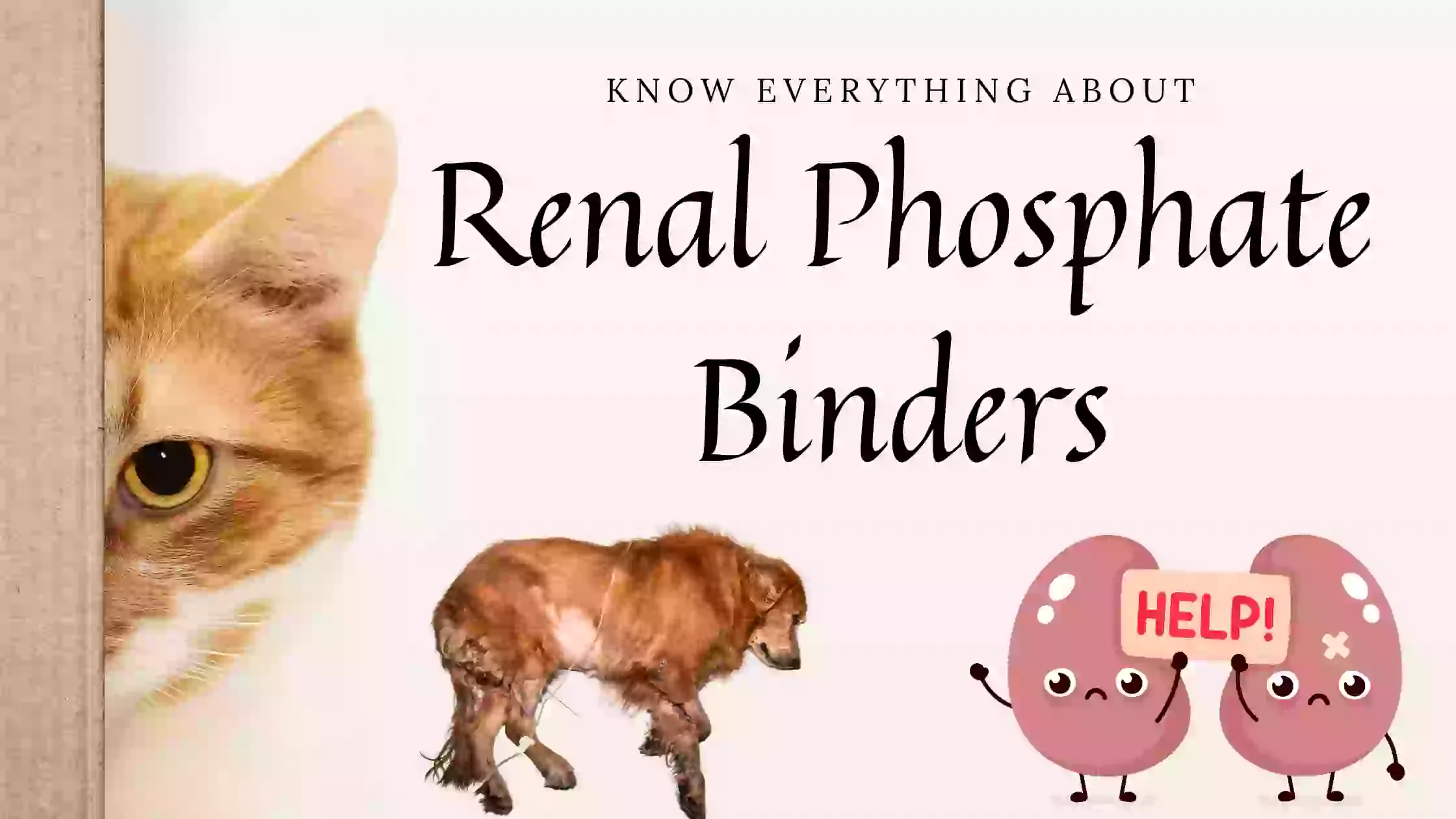



Pingback: SDMA (Symmetric dimethylarginine) – The Veterinary Medicine
Hello
Is there a way to order in Greece ?
Thank you
Hi,
Thank you for writing to us.
Hope our efforts have helped you but we are extremely sorry that we are not dealing with sales.
Regards